![]()
S Jiang, L Liu, P Peng, M Xu, R Yan*
Prediction of vessel arrival time to port: a review of current studies
Maritime Policy & Management, 2025, 1-26
read the abstract
Accurate prediction of vessel arrival time is crucial for the efficiency of port operations and international trade; however, a systematic review of the research on this topic has not yet been conducted. This paper provides the first systematic review of the prediction of vessel arrival time to port, encompassing 29 academic studies published since 2011. By reviewing the literature, it first identifies and categorizes six key factors affecting vessel arrival time prediction: vessel static information, dynamic information, route conditions, environmental conditions, human factors, and external unexpected factors. The review highlights the challenges of precise vessel arrival time prediction. After closely examining the existing research studies, we found that two frameworks, namely non-trajectory-based prediction of vessel’s ETA to port and prediction of vessel’s ETA to port by path finding, and four categories of prediction models are commonly used: statistical models, machine learning models, deep learning models, and reinforcement learning models. This review also explores potential future research directions and serves as a critical resource for feature usage, model selection, the current research state, and future development directions for researchers, industry practitioners, and policymakers, advancing the understanding and application of data-driven prediction methodologies for improved maritime operational efficiency and digitalization.
HTMLARTICLE
![]()
Liang Zhao, Mengqiao Xu, Lei Liu, Yong Bai, Mingyang Zhang* & Ran Yan*
Intelligent shipping: integrating autonomous maneuvering and maritime knowledge in the Singapore-Rotterdam Corridor
Communications Engineering, 2025, 4:11
read the abstract
Designing safe and reliable routes is the core of intelligent shipping. However, existing methods for industrial use are inadequate, primarily due to the lack of considering company preferences and ship maneuvering characteristics. To address these challenges, here we introduce a methodological framework that integrates maritime knowledge and autonomous maneuvering model. Based on historical maritime big data, the framework offers customized routes for companies with specific routing preferences. The autonomous maneuvering model then evaluates the safety and reliability of the routes by considering ship motion characteristics and ocean hydrodynamics. We validate its effectiveness on the world’s longest Green and Digital Shipping Corridor between Singapore and Rotterdam. Results demonstrate that our model can provide customized route design for companies and enhance safety for shipping. The framework could serve as a fundamental structure to build a fully digitalized platform for route customization and evaluation for global shipping, optimizing operational decision-making and safety assurance.
HTMLARTICLE
![]()
Mengqiao Xu*, Yihui Shen, Yifan Zhu, Li Hong, Mengzhi Ma, Linyuan Lü*, Kevin X. Li*
Identification of critical sets of ports in cascading failures of global liner shipping network
Transportation Research Part E: Logistics and Transportation Review, 2025, 200: 104184
read the abstract
Cascading failures of port congestion propagation have become increasingly frequent in the global liner shipping network (GLSN), which harms international trade. To build resilience in maritime logistics, it is vital to proactively identify critical port sets whose initial failure would trigger severe consequences of port congestion propagation. This paper proposes a methodology for critical port sets identification in the cascading failures of GLSN, which integrates a cascading failure simulation model with a meta-heuristic optimization procedure. Specifically, a cascading failure model that considers liner shipping service routes’ port rotation adjustment behavior is introduced first. Then, the identification of critical port sets is formulated as a combinatorial optimization problem, seeking sets of ports whose simultaneous initial disruptions would trigger the largest cascade size; and an improved multi-population genetic algorithm is developed to solve this optimization problem. We demonstrate the usefulness of the proposed methodology by applying it to an empirical case of the GLSN, identifying the top 10 most critial sets of ports under different given values of set size. Extensive computational experiments validate the algorithm’s effectiveness in delivering high-quality solutions of approximate optimality. Results show that the critical sets of ports and their triggered cascade sizes are largely influenced by the service route behaviors of port rotation adjustments, and the influence becomes more profound with the increase in set size. Our proposed methodology serves as a valuable tool for proactively identifying worst-case scenarios of global port congestion propagation, thereby assisting stakeholders in resilient maritime logistics management.
HTMLARTICLE
![]()
Li Hong, Mengqiao Xu*, Yu Liu, Xuemei Zhang, Changjun Fan
A deep learning dismantling approach for understanding the structural vulnerability of complex networks
Chaos, Solitons & Fractals, 2025, 194: 116148
read the abstract
Understanding the structural vulnerability of real-world complex networks is a crucial issue. This issue can be addressed by solving the so-called network dismantling problem, which aims to identify the smallest set of nodes for the fastest dismantling of a network. The network dismantling problem is a computationally challenging task due to its NP-hard nature. The powerful learning capabilities of machine learning methods provide a new perspective for solving this problem. Most existing deep learning methods are based on supervised learning, which rely on pre-labeled training data. These existing methods have achieved promising results in completely dismantling a network. However, they may not perform very well in identifying a very small number of nodes whose removal would significantly degrade—though far from fully dismantle—the network performance. This issue is particularly relevant to many real-world networks like transportation and infrastructure networks. This paper proposes a novel unsupervised learning model called GASC (Graph Attention network integrated with Shortcut Connections mechanism), to address this issue regarding the network dismantling problem. The GASC model employs the graph attention network to learn the underlying features of a network's topological structure and integrates the shortcut connections mechanism to overcome the vanishing gradients problem. Besides, we incorporate a network tailoring method to further improve the performance of our model. We performed comprehensive experiments on both synthetic networks and various real-world networks. The results validate that the proposed approach outperforms existing state-of-the-art methods and demonstrates significant robustness.
HTMLARTICLE
![]()
Li Hong, Yu Liu, Mengqiao Xu*, and Wenhui Deng
Combining deep reinforcement learning with heuristics to solve the traveling salesman problem
Chinese Physics B, 2025, 34(1): 018705
read the abstract
Recent studies employing deep learning to solve the traveling salesman problem (TSP) have mainly focused on learning construction heuristics. Such methods can improve TSP solutions, but still depend on additional programs. However, methods that focus on learning improvement heuristics to iteratively refine solutions remain insufficient. Traditional improvement heuristics are guided by a manually designed search strategy and may only achieve limited improvements. This paper proposes a novel framework for learning improvement heuristics, which automatically discovers better improvement policies for heuristics to iteratively solve the TSP. Our framework first designs a new architecture based on a transformer model to make the policy network parameterized, which introduces an action-dropout layer to prevent action selection from overfitting. It then proposes a deep reinforcement learning approach integrating a simulated annealing mechanism (named RL-SA) to learn the pairwise selected policy, aiming to improve the 2-opt algorithm's performance. The RL-SA leverages the whale optimization algorithm to generate initial solutions for better sampling efficiency and uses the Gaussian perturbation strategy to tackle the sparse reward problem of reinforcement learning. The experiment results show that the proposed approach is significantly superior to the state-of-the-art learning-based methods, and further reduces the gap between learning-based methods and highly optimized solvers in the benchmark datasets. Moreover, our pre-trained model M can be applied to guide the SA algorithm (named M-SA (ours)), which performs better than existing deep models in small-, medium-, and large-scale TSPLIB datasets. Additionally, the M-SA (ours) achieves excellent generalization performance in a real-world dataset on global liner shipping routes, with the optimization percentages in distance reduction ranging from 3.52% to 17.99%.
HTMLARTICLE
![]()
Tao Li, Yu Qin, Mengqiao Xu, Yanjie Zhou*, Lili Rong
Spatio-temporal vulnerability of high-speed rail line network in China
Transportation Research Part D: Transport and Environment, 2024(131): 104338
read the abstract
Previous literature mainly focuses on the vulnerability of high-speed rail network (HSRN) at station level. High-speed rail (HSR) lines fail frequently due to disasters, which can cause a cascading effect between lines. We propose a novel method to assess the vulnerability of HSR line network (HSRLN) from the spatio-temporal perspective. To do that, the lines are described by stations, and the relations between lines are defined by train scheduling data. Then, we use the passenger volume and travel time cost between lines to assess HSRLN’s vulnerability with disasters’ spatio-temporal characteristics. Finally, the HSRLN in China is taken as a case. When a disaster occurs at 11:00 and lasts 6 h or 9 h, it can cause a large vulnerability. The critical lines always cover the Beijing-Shanghai and Shanghai-Kunming lines, while the regions with high-level vulnerability are mainly distributed in the Yangtze River Delta.
HTMLARTICLE
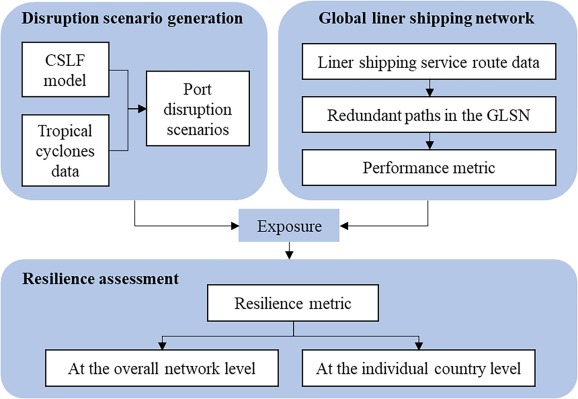
Mengqiao Xu*, Yifan Zhu, Kaishuo Liu, Adolf K. Y. Ng
Assessing resilience of global liner shipping network to tropical cyclones
Transportation Research Part D: Transport and Environment, 2024: 104189
read the abstract
Tropical cyclones (TCs) are the primary natural disaster causing port disruptions, yet their impacts on global maritime transport remain largely unknown. This paper develops a framework to assess the resilience of global liner shipping network (GLSN) to TCs, focusing on path redundancy. The framework considers both direct and indirect impacts of port disruptions on GLSN performance in TC scenarios. We demonstrate this framework through case studies under historical and stress-test TC scenarios in the Western North Pacific region. Results show that the GLSN can be quite resilient in typical or mild-stress scenarios, but the increasing decline in its resilience under higher stress levels signals significant risks when facing with extreme scenarios. Those least resilient countries under mild stress turn out to be the same countries exhibiting least resilience under severe stress, most of which are SIDS countries. This research has implications for the design of resilient maritime transport networks.
HTMLARTICLE
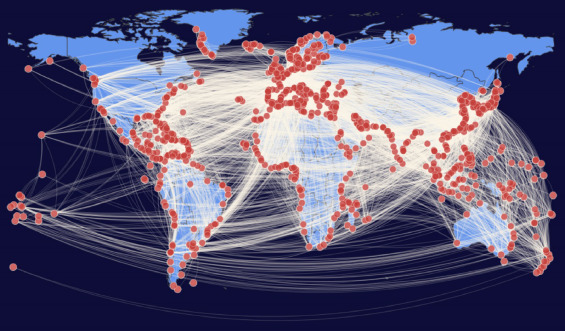
Mengqiao Xu*, Wenhui Deng, Yifan Zhu, Linyuan LÜ*
Assessing and improving the structural robustness of global liner shipping system: A motif-based network science approach
Reliability Engineering and System Safety, 2023, 240: 109576
read the abstract
Liner shipping carries about 70% of the total value of world's seaborne trade, and thus the robust functioning of global liner shipping network (GLSN) is essential for building robust global maritime logistics systems. However, understanding and improving the underlying structural robustness of GLSN is an important challenging topic. This paper contributes to this topic by proposing a motif-based network science approach to address two crucial tasks therein. First, based on the extensive mining of four-node motifs in the GLSN, we propose a novel node centrality metric named motif centrality to characterize the importance of a port in the GLSN, which proves its effectiveness in identifying critical ports for maintaining the GLSN structural robustness. Second, after assessing the GLSN structural robustness against some worst-case scenarios of port disruptions, we propose two motif-based link-adding strategies to improve the GLSN structural robustness. Experimental results prove their effectiveness as compared with random link-adding strategies. For further scrutinization, one strategy is extended to the individual country level and is found useful in improving the structural robustness of liner shipping connections of most countries, especially many underdeveloped maritime countries. Some practical and theoretical implications are finally discussed.
HTMLARTICLE
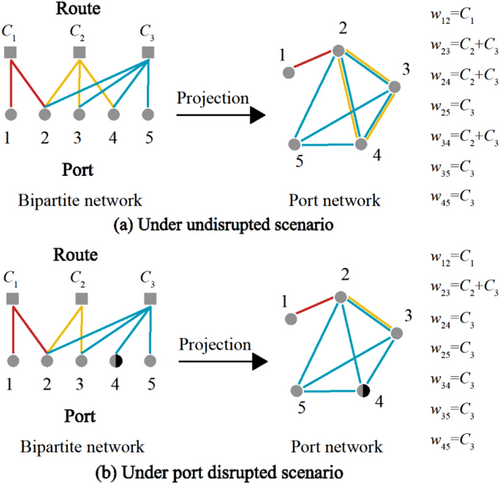
Xu, M.*, Zhu, Y., Deng, W., Shen Y., & Li, T*
Assessing the efficiency and vulnerability of global liner shipping network
Global Networks, 2023, 1–27
read the abstract
Global liner shipping network (GLSN) constitutes an essential part of global maritime supply chains, but it could be vulnerable to disruptions. This paper develops an integrated framework for assessing the efficiency and vulnerability of GLSN. Specifically, a novel efficiency metric is proposed to quantify the performance of GLSN, and the framework enables modeling different levels of port disruption scenarios. Results show that the overall GLSN is quite robust under the partial disruption scenario of any single port (or of any single country's ports), but the damage to different countries is highly heterogeneous. Under dismantling scenarios where the identified most critical ports (countries) are successively disrupted, the GLSN vulnerability increases non-linearly with an increasing level of disruption. Our findings demonstrate that it is necessary to monitor and protect the identified critical ports (countries); especially, avoiding their simultaneously complete disruptions is of vital importance to the robust functionality of GLSN.
HTMLARTICLE
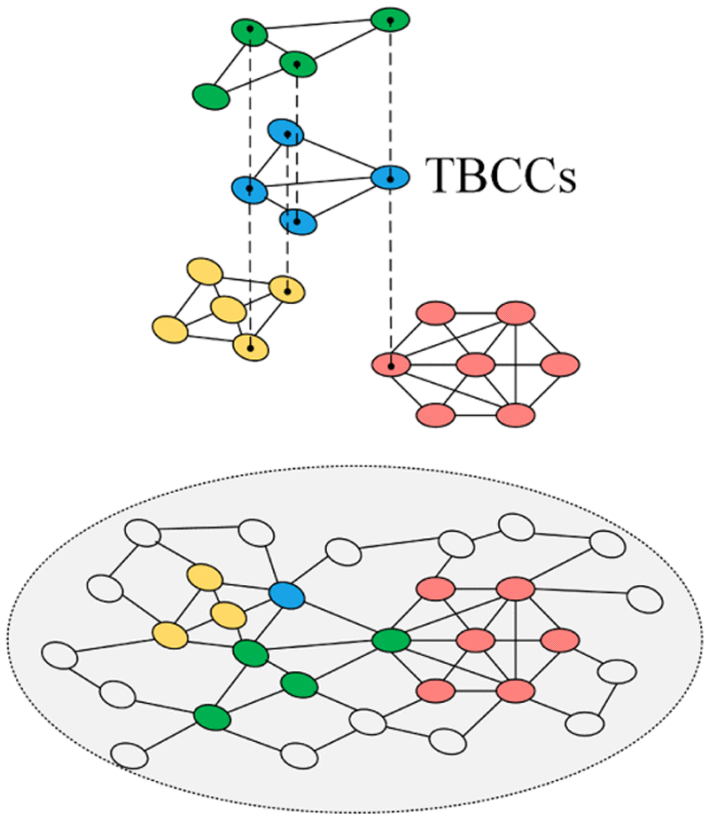
Xueming Liu, Yue Xu, Mengqiao Xu*, Wenhui Deng, Linqiang Pan, Adolf K. Y. Ng.
Two-Hop Biconnected Components in the Global Liner Shipping Network Reveal International Trade Statuses.
IEEE Transactions on Network Science and Engineering, 2023,10(3): 1564-1574
read the abstract
Over 80% of global trade is carried by sea, and 70% of global seaborne trade by value is realized by liner shipping. The global liner shipping network (GLSN) is essential to facilitating international trade. To explore the transportation mechanism of the GLSN, we study a structure termed “two-hop biconnected component”(TBCC) which is a type of highly robust and efficient connected local structure. We find that TBCC is a salient structural property of the GLSN and is strongly associated with international trade statuses. Ports that appear more frequently in TBCCs tend to gain higher container throughputs in reality and play more important roles in maintaining the overall network robustness. Furthermore, we find that countries belonging to the same TBCCs tend to have closer trading relationships and form meaningful multilateral trade clusters in the future. The discovery of TBCC can help better understand international trade statuses and enable better design of robust and efficient liner shipping service routes.
HTMLARTICLE

Xiujuan Xu, Yifan Zhu, Mengqiao Xu*, Wenhui Deng, Yuqing Zuo.
Vulnerability analysis of the global liner shipping network: from static structure to cascading failure dynamics.
Ocean and coastal management, 2022,
read the abstract
Robust maritime transportation networks are essential to the development of world economy. But vulnerability of the global liner shipping network (GLSN) to unexpected interruptions has become apparent since the COVID-19 pandemic began, in that a single port interruption could be sufficient to trigger a cascading failure (i.e., port congestion propagation). To understand the vulnerability of the GLSN under such cascading failures, we propose a novel cascading model, which incorporates the realistic factor of liner shipping service routes’ behavior of port rotation adjustments under port failures. We apply the model to an empirical GLSN, showing that the GLSN under cascading failures is significantly more vulnerable than its static structure. Regarding two common adjustments of service routes’ port rotations (i.e., skipping failed ports and choosing alternative ports), we find that choosing alternative ports increases the GLSN vulnerability to cascading failures. Within the proposed model, we also introduce a metric termed port dynamic criticality to characterize the contribution of each port to the overall network robustness against cascading failures, finding it significantly and positively associated with port’s topological centrality in the initial GLSN. These findings provide managerial insights into preventing or mitigating port congestion propagation in the GLSN.
HTMLARTICLE
HTMLKEY RESULTS & VISUALIZATION
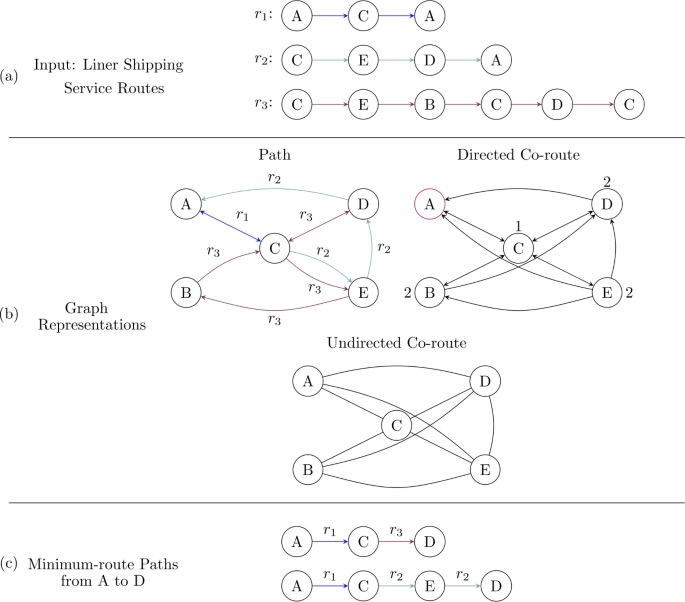
Timothy LaRock, Mengqiao Xu*, Tina Eliassi-Rad
A Path-based Approach to Analyzing the Global Liner Shipping Network
EPJ Data Science. 2022
read the abstract
The maritime shipping network is the backbone of global trade. Data about the movement of cargo through this network comes in various forms, from ship-level Automatic Identification System (AIS) data, to aggregated bilateral trade volume statistics. Multiple network representations of the shipping system can be derived from any one data source, each of which has advantages and disadvantages. In this work, we examine data in the form of liner shipping service routes, a list of walks through the port-to-port network aggregated from individual shipping companies by a large shipping logistics database. This data is inherently sequential, in that each route represents a sequence of ports called upon by a cargo ship. Previous work has analyzed this data without taking full advantage of the sequential information. Our contribution is to develop a path-based methodology for analyzing liner shipping service route data, computing navigational trajectories through the network that respect the routes and comparing these paths with those computed using other network representations of the same data. We further use these trajectories to re-analyze the role of a previously-identified structural core through the network, as well as to define and analyze a measure of betweenness centrality for nodes and edges.
HTMLARTICLE
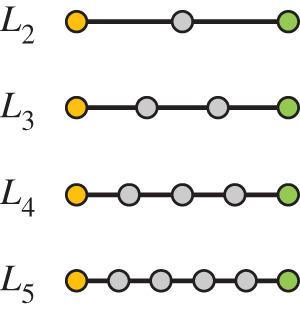
Mengqiao Xu , Qian Pan, Haoxiang Xia, Naoki Masuda*.
Estimating international trade statuses of individual countries from a global liner shipping network.
Royal Society Open Science, 2020, 7: 200386
read the abstract
Maritime shipping is a backbone of international trade and, thus, the world economy. Cargo-loaded vessels travel from one country's port to another via an underlying port-to-port transport network, contributing to international trade values of countries en route. We hypothesize that ports that involve trans-shipment activities serve as a third-party broker to mediate trade between two foreign countries and contribute to the corresponding country's status in international trade. We test this hypothesis using a port-level dataset of global liner shipping services. We propose two indices that quantify the importance of countries in the global liner shipping network and show that they explain a large amount of variation in individual countries' international trade values and related measures. These results support a long-standing view in maritime economics, which has yet to be directly tested, that countries that are strongly integrated into the global maritime transportation network have enhanced access to global markets and trade opportunities.
HTMLARTICLE
HTMLCODE
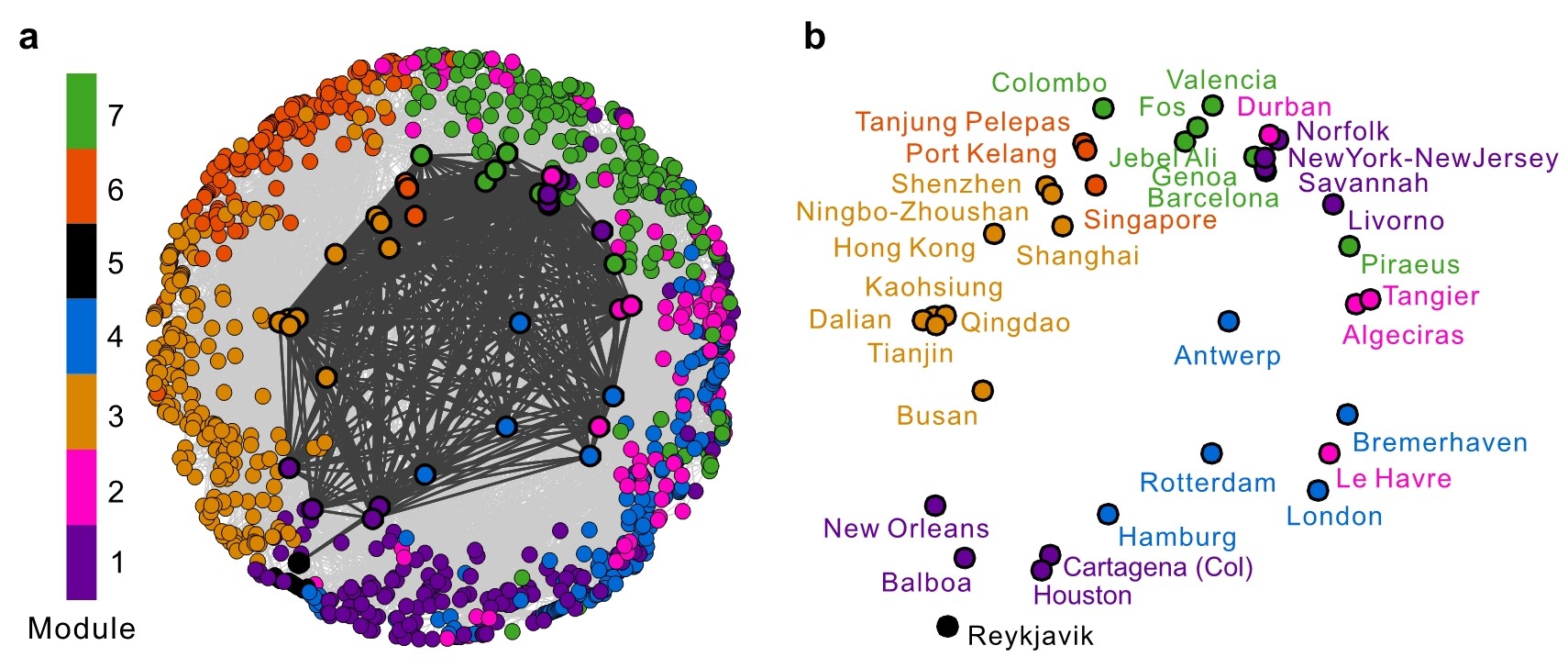
Mengqiao Xu# *, Qian Pan#, Alessandro Muscoloni, Haoxiang Xia*, Carlo Vittorio Cannistraci*.
Modular gateway-ness connectivity and structural core organization in maritime network science.
Nature Communications, 11, 2849 (2020)
read the abstract
Around 80% of global trade by volume is transported by sea, and thus the maritime transportation
system is fundamental to the world economy. To better exploit new international shipping routes,
we need to understand the current ones and their complex systems association with international
trade. We investigate the structure of the global liner shipping network (GLSN), finding it is an
economic small-world network with a trade-off between high transportation efficiency and low
wiring cost. To enhance understanding of this trade-off, we examine the modular segregation of
the GLSN; we study provincial-, connector-hub ports and propose the definition of gateway-hub
ports, using three respective structural measures. The gateway-hub structural-core organization
seems a salient property of the GLSN, which proves importantly associated to network integration
and function in realizing the cargo transportation of international trade. This finding offers new
insights into the GLSN’s structural organization complexity and its relevance to international trade.
HTMLARTICLE
XLSXDATA
HTMLCODE

Sadamori Kojaku#, Mengqiao Xu #, Haoxiang Xia, Naoki Masuda*.
Multiscale core-periphery structure in a global liner shipping network.
Scientific Reports, 2019, 9(1): 404.
read the abstract
Maritime transport accounts for a majority of trades in volume, of which 70% in value is carried by container ships that transit regular routes on fixed schedules in the ocean. In the present paper, we analyse a data set of global liner shipping as a network of ports. In particular, we construct the network of the ports as the one-mode projection of a bipartite network composed of ports and ship routes. Like other transportation networks, global liner shipping networks may have core-periphery structure, where a core and a periphery are groups of densely and sparsely interconnected nodes, respectively. Core-periphery structure may have practical implications for understanding the robustness, efficiency and uneven development of international transportation systems. We develop an algorithm to detect core-periphery pairs in a network, which allows one to find core and peripheral nodes on different scales and uses a configuration model that accounts for the fact that the network is obtained by the one-mode projection of a bipartite network. We also found that most ports are core (as opposed to peripheral) ports and that ports in some countries in Europe, America and Asia belong to a global core-periphery pair across different scales, whereas ports in other countries do not.
HTMLARTICLE
![]()
Mengqiao Xu*, Ling Zhang, Wen Li, Haoxiang Xia.
Mobility pattern of taxi passengers at intra-urban scale: empirical study of three cities.
Journal of Systems Science and Information, 2017, 5(6), 537-555.
read the abstract
The study of human mobility patterns is of both theoretical and practical values in many aspects. For long-distance travel, a few research endeavors have shown that the displacements of human travels follow a power-law distribution. However, controversies remain regarding the issue of the scaling laws of human mobility in intra-urban areas. In this work, we focus on the mobility pattern of taxi passengers by examining five datasets of three metropolitans. Through statistical analysis, we find that the lognormal distribution with a power-law tail can best approximate both the displacement and the duration time of taxi trips in all the examined cities. The universality of the scaling laws of human mobility is subsequently discussed, in view of the analysis of the data. The consistency of the statistical properties of the selected datasets that cover different cities and study periods suggests that, the identified pattern of taxi-based intra-urban travels seems to be ubiquitous over cities and time periods.
HTMLARTICLE
Mengqiao Xu*, Haoxiang Xia.
Hub dependency and vulnerability of China's overseas connections. In: Cesar Ducruet (Ed.), Advances in Shipping Data Analysis and Modeling:
Tracking and Mapping Maritime Flows in the Age of Big Data, 2017. London: Routledge. (Book chapter)
arXiv preprint,arXiv preprint,arXiv preprint,arXiv preprint,arXiv preprint,dd
HTMLARTICLE
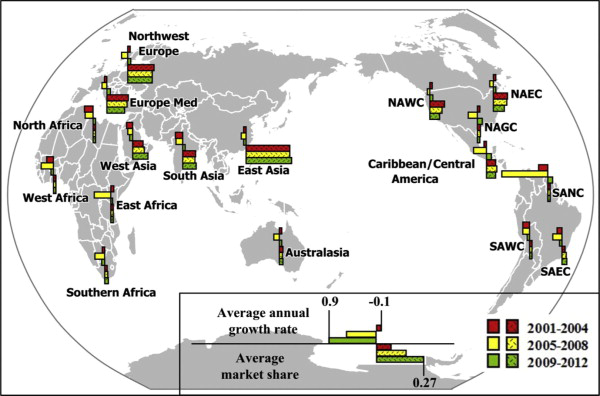
Mengqiao Xu*, Zhenfu Li, Yanlei Shi, Xiaoling Zhang, Shufei Jiang.
Evolution of regional inequality in the global shipping network.
Journal of Transport Geography, 2015, 44: 1-12.
read the abstract
Global shipping is a backbone of the global economy, and as such, it evolves alongside the development of trade and the elaboration of commodity chains. This paper investigates the evolution of regional inequality in the global shipping network by analyzing the changing positions of world regions during the period from 2001 to 2012. This was a period of both prosperity and recession in maritime shipping. Using data on inter-regional flow connections, the positions of seventeen regions in the global shipping network are analyzed in terms of their traffic development, centrality, dominance and vulnerability. The East Asian, Northwest European and Europe Mediterranean regions have consistently held the highest positions, while East African and North African regions have held the lowest positions. By commanding the largest flows in the network, East Asia assumes a dominant position. The Australasian, North American West Coast, Northwest European and Southern African regions show an increasing dependency on East Asia. The analysis also identifies a few emerging regions that have had the highest growth rates in total traffic volume and connectivity for the studied period, namely South American North Coast, South American East Coast, West Africa, Southern Africa and West Asia. The empirical results of this paper supplement existing research on global shipping network evolution. One implication of the analysis is that the traffic growth of East Asia does not imply that, there is an equivalent improvement in its position in the global shipping network. The paper also shows that indicators from network analysis may be used to provide a more nuanced understanding of port-regional development than existing measures based solely on total traffic volume.
HTMLARTICLE
![]()
Zhenfu Li, Mengqiao Xu*, Yanlei Shi.
Centrality in global shipping network basing on worldwide shipping areas.
GeoJournal, 2015, 80(1): 47-60.
read the abstract
Port and maritime studies dealing with containerization have observed close correlation between global liner shipping and world trade, and centrality in global shipping network (GSN) may change as the situation of world economy and trade changes. Meanwhile, the influence that shipping areas have on the GSN is much greater than any single port, and connections between these shipping areas affect the structure of the GSN. This paper wishes to understand the dynamic changing of the centrality in the GSN during the period from 2001 to 2012, which sees both booms and depressions in world economy and liner shipping. The paper divides global shipping into 25 areas from geographical perspective, and presents an analysis of each shipping area’s position in the GSN through indicators of centrality. The results reveal that to a large extent Europe is always in the center of the GSN from 2001 to 2012, but its central position is declining. Additionally, mapping the centrality distribution of those shipping areas in the latest year confirms their current positions in the GSN.
HTMLARTICLE
Mengqiao Xu*, Zhenfu Li, Yanlei Shi, Xiaoling Zhang, Shufei Jiang.
Spatial linkage of global container shipping network.
Journal of Shanghai Maritime University, 2015, 36(3): 6-12. (in Chinese)
arXiv preprint,arXiv preprint,arXiv preprint,arXiv preprint,arXiv preprint,dd
HTMLARTICLE
Zhenfu Li, Wanying Li, Mengqiao Xu.
Centrality of Maritime Silk Road Container Shipping Network.
Navigation of China, 2018, 41(3): 126-131, 137. (in Chinese)
HTMLARTICLE
Zhenfu Li, Shiyan Liu, Mengqiao Xu.
Structural Vulnerability of Chinese Inland Waterway Container Shipping Network.
Areal Research and Development, 2018, 37(3): 13-18. (in Chinese)
HTMLARTICLE
Zhenfu Li, Aimei Liang, Mengqiao Xu.
Author network of Arctic social science research in China.
World Regional Studies, 2018, 27(3): 33-44. (in Chinese)
HTMLARTICLE
Zhenfu Li, Yanlei Shi, Mengqiao Xu, Xiaoling Zhang, Shufei Jiang.
Hierarchical structure in the global liner shipping network.
Systems Engineering - Theory & Practice, 2016, 36(4): 981-988 (in Chinese)
HTMLARTICLE
Zhenfu Li, Yanlei Shi, Mengqiao Xu, Xiaoling Zhang.
Position of the Asian Container Ports in Global Liner Shipping Network.
Economic Geography, 2016, 36(3): 91-98. (in Chinese)
HTMLARTICLE
Zhenfu Li, Shufei Jiang, Mengqiao Xu, Yanlei Shi, Xiaoling Zhang.
On the Shipping Network Evolution Under the Arctic Route.
Complex Systems and Complexity Science, 2015, 12(4):55-60 (in Chinese)
HTMLARTICLE
Zhenfu Li, Xiaoling Zhang, Mengqiao Xu, Yanlei Shi, Shufei Jiang.
Hierarchies in East Asian Container Port System.
Systems Engineering, 2015,33(12):78-84. (in Chinese)
HTMLARTICLE
Zhenfu Li, Xiaoling Zhang, Mengqiao Xu, Yanlei Shi.
Containerization in East Asian container port system.
Journal of Beijing Jiaotong University, 2015, 39(3): 48-55. (in Chinese)
HTMLARTICLE
Zhengfu Li, Wenya Wang, Mengqiao Xu.
PT-based China's Right Strategy Choice on Arctic Route.
World Regional Studies, 2015, 24(3): 50-58. (in Chinese)
HTMLARTICLE
Zhenfu Li, He Li, Mengqiao Xu, Yanlei Shi.
Comparison research on reachability of the global shipping network.
Journal of Dalian Maritime University, 2014, 40(1): 101-104. (in Chinese)
HTMLARTICLE
Zhenfu Li, He Li, Mengqiao Xu, Yi Li.
Research on the Evolution and Future Tendency of Global Shipping Network.
Pacific Journal, 2014, 22(5): 95-105. (in Chinese)
HTMLARTICLE










